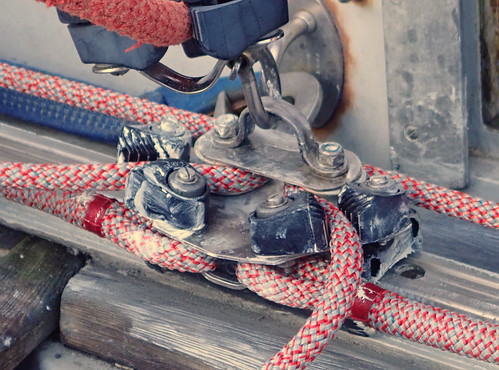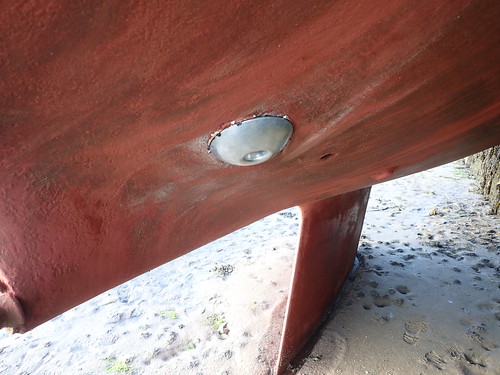I had 'Raasay' alongside the quay in Findhorn for a couple of days of 'harbour-caravanning', and took it back across to the mooring just before high tide today.
An hour before high tide, there is still a strong tidal current in 'D' section, and the wind from the SW was not quite against it, but crossing it steeply. I could see 'Astrea' on the next mooring along being pushed up tide by the wind, but still lying to the tide. Picking up the mooring on my own was going to take a couple of attempts.
I worked out a mode of approach after some trial and error, and was creeping across the tide, pointing down wind, and letting the boat drift towards the mooring. It's always tricky to time the jump from the helm to the boat hook and I left it about a second too long. By the time I got to the pickup bouy it was being dragged under the boat. 'First attempt...' I thought, and waited for it to come out the other side.
It didn't. It snagged on something under the boat and hung on tight.
The engine was running but I daren't engage the prop, so I just let things take their course to see how the boat would lie before I tried to figure out what had happened. I tried the tiller and found it almost impossible to move, so reckoned the bouy must be jammed in the rudder somehow. I confirmed this by taking a couple of pictures over the side (it's handy to have a waterproof camera ...), in which I could see the buoy stuck near the tip of the rudder - the rope was between the rudder and the base of the skeg (which holds the bottom rudder bearing).
I waited a little to see if it would just come unstuck, and wondered what to do. I didn't want to cut the rope, but it was beginning to seem unavoidable. I taped a knife to the boathook, and got to work.
It was very awkward - every time the knife slipped off the rope I had to start again, because the rope was so far under the water I couldn't see where I was cutting. I could feel the serrated blade making some kind of progress, though.
After five or ten minutes, the bouy suddenly popped out of where it had lodged itself and floated free - still attached to the pick up rope, which was now severely damaged by my attempts to cut through it.
Later, I thought more carefully about how the lower rudder bearing on the Rival worked, and realised that the only way the rope could get stuck was straight up between the bearing support and the bottom of the rudder. A gentle push down - as supplied by someone trying to cut the rope, for instance - was all it would have taken to free it.
I brought the boat round again, and almost by luck found myself approaching the pickup buoy at a hopeful angle. I motored gently towards it, grabbed the boat hook, and pulled in on board. I had just assessed the damage - two strands cut through and a serious start on the third - when I realised that I'd left the prop engaged, and the buoy was being dragged out of my hands.
I managed to lodge it around a shroud, dive into the cockpit to disengage the prop, and get back to it before the remaining strand snapped or it worked itself free.
The remainder of the process was, as usual, still a bit fraught. It's hard to get the mooring strop on board through Raasay's rather tight bow roller arrangement, so I have winch it. It was nice to get on with the normal difficulties, though, and get the boat secured.
I won't be so casual about letting the mooring go under the boat in future. And, if it does, and the pickup buoy gets stuck in the rudder, I won't go straight for the most desperate option ...
Now the tide has turned, the boat is lying quietly to the dropping wind and the ebb. Maybe time for a cup of tea.
Sunday, 26 August 2018
Sunday, 22 July 2018
Terschelling Onwards
I'll give a list of dates presently, but from Terschelling we spent a night at anchor in the Waddenzee (see 'A Night at Sea', from Riddle of the Sands). Then to Den Oever and through the locks.
The Dutch are very generous with their locks and canals - with the exception of a small (total about 20 euros) charge for going through Haarlem everything was free. The marinas were also cheap, and there were places where I could tie up for nothing (often in town centres).
Two days in central Amsterdam in the Marina het Realeniland (in the Westerdok) only cost 50 euros with power. It was quaint rather than fully serviced, but very pleasant. They don't have many places - I think I got the only one, and had to raft up on the first night. If you want to follow me in, phone ahead!
The route into the Westerdok is a little bit hair-raising - small bridges and Amsterdam canals - but very atmospheric.
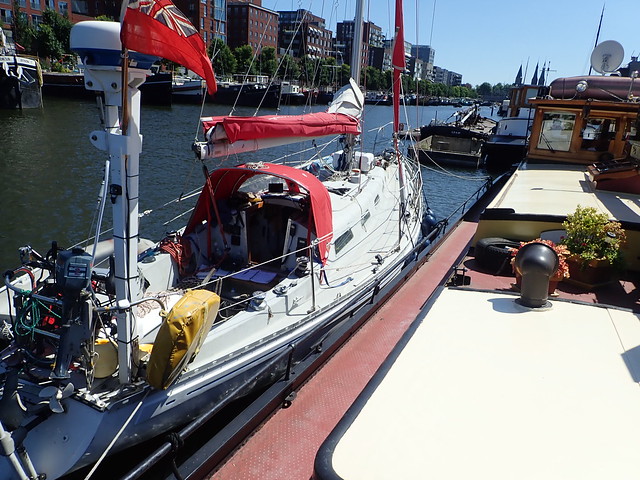
The Dutch are very generous with their locks and canals - with the exception of a small (total about 20 euros) charge for going through Haarlem everything was free. The marinas were also cheap, and there were places where I could tie up for nothing (often in town centres).
Two days in central Amsterdam in the Marina het Realeniland (in the Westerdok) only cost 50 euros with power. It was quaint rather than fully serviced, but very pleasant. They don't have many places - I think I got the only one, and had to raft up on the first night. If you want to follow me in, phone ahead!
The route into the Westerdok is a little bit hair-raising - small bridges and Amsterdam canals - but very atmospheric.

Peterhead to Vlieland
After trying & failing to get hold of the marina manager in Peterhead, I decided to go with what I thought was about fifty hours of fuel on board (I can carry about four days). We left the marina at 09:35.
On the first day (Thursday) we used the engine for 4 hours. At 23:40 we were getting too little wind to sail, and switched it on again. It was switched off again at 18:15 on the 7th. Total so far, about 46 hours. We had 10 hours left in the main tank, which I thought we should keep for final approach and manoeuvring.
I had drained the reserve from full, getting 39 hours - a useful statistic. I then switched tanks, bled the diesel, and switched it off again.
We were utterly becalmed until 03:00 on the 8th (Saturday morning), so we lost 9 hours because of the fuel shortage. We then sailed towards the channel between Terschelling and Vlieland. The winds were very light, and we were slow - the spinnaker was up for about 8 hours from 09:30g.
At 17:30 we put the engine back on to motor for the last six hours, tying up in Vlieland just before midnight.
In the interim, Carrie had become concerned about our late arrival, and had asked the coastguard if they had heard from us. This resulted in a Pan Pan and a Navtex report, so we were much better known than we expected to be by the time we arrived. I hadn't seen the Navtex report because I had only looked at weather forecasts ...
I should have been much clearer about the range of possibilities.
And I should have been more careful about fuel ...
We stayed two nights in Vlieland, recovering and sightseeing, and filling the tanks, before moving on to Terschelling for a night.
On the first day (Thursday) we used the engine for 4 hours. At 23:40 we were getting too little wind to sail, and switched it on again. It was switched off again at 18:15 on the 7th. Total so far, about 46 hours. We had 10 hours left in the main tank, which I thought we should keep for final approach and manoeuvring.
I had drained the reserve from full, getting 39 hours - a useful statistic. I then switched tanks, bled the diesel, and switched it off again.
We were utterly becalmed until 03:00 on the 8th (Saturday morning), so we lost 9 hours because of the fuel shortage. We then sailed towards the channel between Terschelling and Vlieland. The winds were very light, and we were slow - the spinnaker was up for about 8 hours from 09:30g.
At 17:30 we put the engine back on to motor for the last six hours, tying up in Vlieland just before midnight.
In the interim, Carrie had become concerned about our late arrival, and had asked the coastguard if they had heard from us. This resulted in a Pan Pan and a Navtex report, so we were much better known than we expected to be by the time we arrived. I hadn't seen the Navtex report because I had only looked at weather forecasts ...
I should have been much clearer about the range of possibilities.
And I should have been more careful about fuel ...
We stayed two nights in Vlieland, recovering and sightseeing, and filling the tanks, before moving on to Terschelling for a night.
Lowestoft
I'm in the Royal Norfolk and Suffolk Yacht Club marina, in Lowestoft. I'm going to pick up the north going tide this evening and sail round to Cromer - where I will anchor off.
Conditions are in my favour, and there aren't so many places I can stop until I get north of the Humber estuary.
I'll be following the tides.
I sailed fifty miles out of Stellendam yesterday, starting about 4:30 - just before first light. I thought I was going to go to Walton, or maybe Harwich, because that was the best course I could make. Then the wind began to die & I decided that if I was going to motor I might as well head for Lowestoft, which was further on my way and also five or ten miles closer.
So here I am.
I'll post some links to photos and stories presently ... I've realised that doing this in some sort of orderly way is a fond hope.
Conditions are in my favour, and there aren't so many places I can stop until I get north of the Humber estuary.
I'll be following the tides.
I sailed fifty miles out of Stellendam yesterday, starting about 4:30 - just before first light. I thought I was going to go to Walton, or maybe Harwich, because that was the best course I could make. Then the wind began to die & I decided that if I was going to motor I might as well head for Lowestoft, which was further on my way and also five or ten miles closer.
So here I am.
I'll post some links to photos and stories presently ... I've realised that doing this in some sort of orderly way is a fond hope.
Wednesday, 18 July 2018
Catching up - Portsoy and Peterhead
I've got some catching up to do.
On the 29th of June, Edan and I took Raasay through to Portsoy for the boatshow.
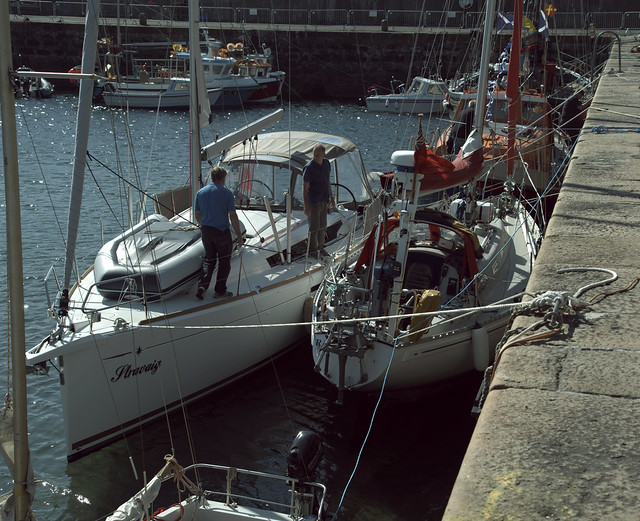
We had an uncomfortable night on the first night because she settled very head down - the slope of the bottom was against us. On Saturday we swapped round.
The weather was blistering.
Portsoy was just the first step in a much larger master plan, though, and on the Monday (2nd July) I sailed round to Peterhead.

I did some final checks and tasks, and some business in Aberdeen, and then Angus joined me on Wednesday night to sail for Vlieland on Thursday morning.
I was planning to fill up with diesel in Peterhead, but the marina manager was very difficult to get hold of and I decided to make do with what I had. Surely we wouldn't be motoring for more than 50 hours ...
On the 29th of June, Edan and I took Raasay through to Portsoy for the boatshow.

We had an uncomfortable night on the first night because she settled very head down - the slope of the bottom was against us. On Saturday we swapped round.
The weather was blistering.
Portsoy was just the first step in a much larger master plan, though, and on the Monday (2nd July) I sailed round to Peterhead.

I did some final checks and tasks, and some business in Aberdeen, and then Angus joined me on Wednesday night to sail for Vlieland on Thursday morning.
I was planning to fill up with diesel in Peterhead, but the marina manager was very difficult to get hold of and I decided to make do with what I had. Surely we wouldn't be motoring for more than 50 hours ...
Sunday, 20 May 2018
Mainsheet Traveller
Friday, 18 May 2018
Thursday, 10 May 2018
Sheet Winches
This is one of Raasay's existing - well, up until today - sheet winches:
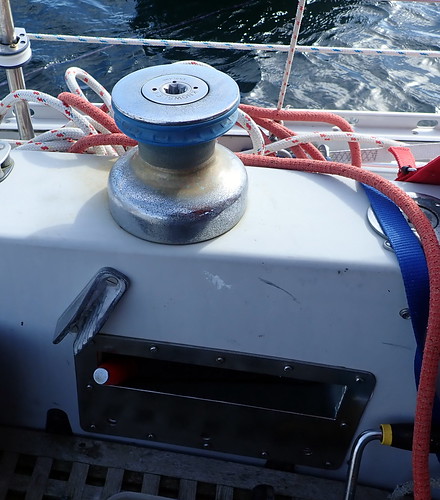
It's a Knowsley, roughly the same size as a Lewmar 40 - or perhaps a size larger. These seem like very good winches (massively heavy, a lot of bearing surface), but they are no longer in production. Also, they are not self-tailing, and I sail single handed a lot.
Also, notice the painful cleat just where you might want to put your back when you are sitting towards the forward end of the cockpit.
Anyhow, I saw a pair of Harken self-tailing winches for sale, reasonably recent, not heavily used, and decided to change them over. The problem was going to be getting at the underside of the mounting area to do the change.
On the starboard side, I might have had someone reach up inside the coaming with a long extension, but the bolts were too long for a socket and getting a ring spanner up there was going to cause joint pain.
On the port side, the coaming is completely inaccessible - it's above the 'long locker', but set inboard of it. I think it's actually impossible to reach.
So: I decided to remove the winch handle pockets, which are separate mouldings behind stainless covers. On the starboard side, the little bolts holding them in place are accessible, but on the port side they are not.
This is the starboard side stripped back:
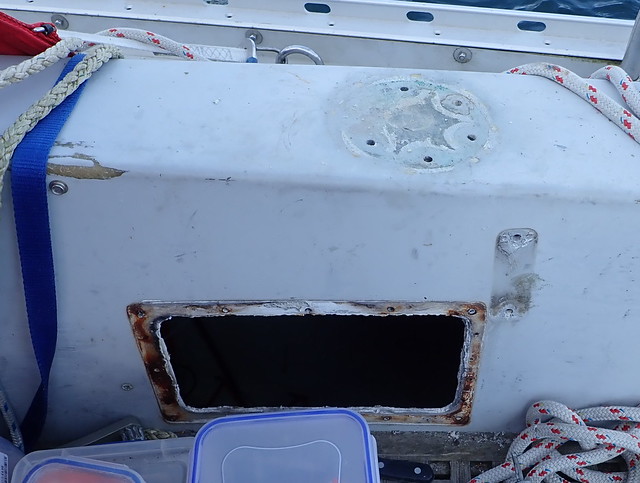
The Knowsley winches weren't original, you can see the traces of earlier version:

The holes didn't (of course) fit the Harken base, so there is another set now ... here is the outcome before the winch pocket was replaced:
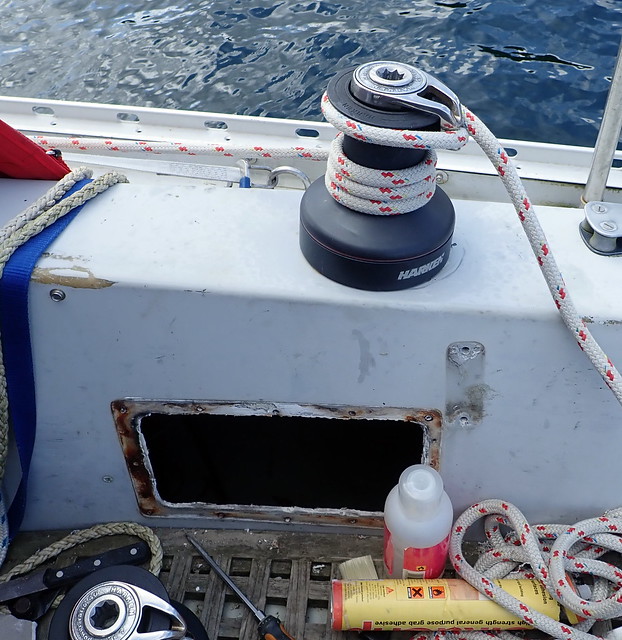
On the port side, I had to grind the heads off the bolts:
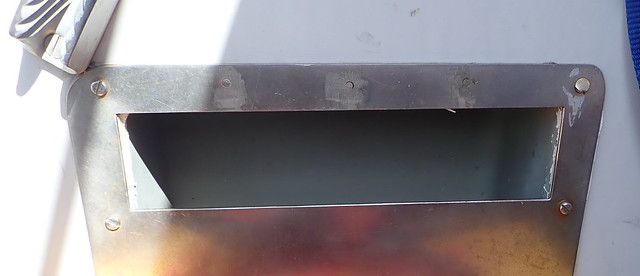
And then replace them with self-tappers into hardwood blocks:
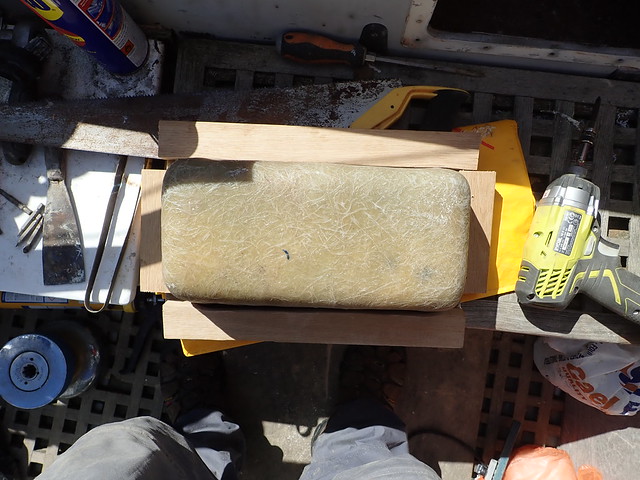
Not a work of art, but then who's going to see it? (Unless ...)
And here is the final outcome, port side:
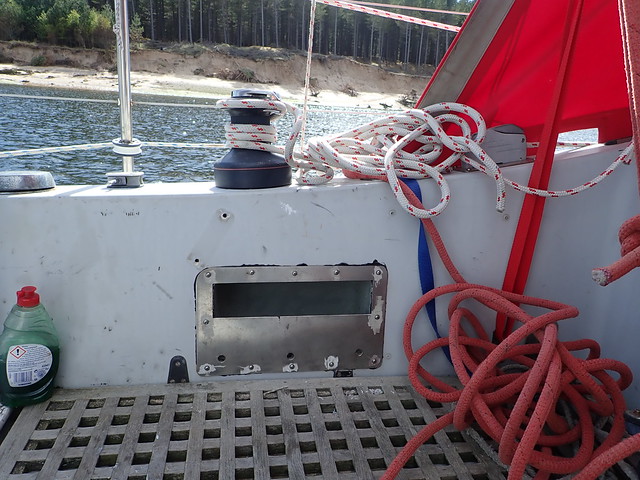
The grinding marks on the plate are much less obvious in the flesh than in this photo. And may tone down ...
I'll trim the excess sealant with a razor once it sets. And there are some holes to patch with epoxy..
But now, I can more conveniently tail my own winches and I can sit comfortably in the cockpit with my back to them ...
Does anyone want a pair of Knowsley winches?

It's a Knowsley, roughly the same size as a Lewmar 40 - or perhaps a size larger. These seem like very good winches (massively heavy, a lot of bearing surface), but they are no longer in production. Also, they are not self-tailing, and I sail single handed a lot.
Also, notice the painful cleat just where you might want to put your back when you are sitting towards the forward end of the cockpit.
Anyhow, I saw a pair of Harken self-tailing winches for sale, reasonably recent, not heavily used, and decided to change them over. The problem was going to be getting at the underside of the mounting area to do the change.
On the starboard side, I might have had someone reach up inside the coaming with a long extension, but the bolts were too long for a socket and getting a ring spanner up there was going to cause joint pain.
On the port side, the coaming is completely inaccessible - it's above the 'long locker', but set inboard of it. I think it's actually impossible to reach.
So: I decided to remove the winch handle pockets, which are separate mouldings behind stainless covers. On the starboard side, the little bolts holding them in place are accessible, but on the port side they are not.
This is the starboard side stripped back:

The Knowsley winches weren't original, you can see the traces of earlier version:

The holes didn't (of course) fit the Harken base, so there is another set now ... here is the outcome before the winch pocket was replaced:

On the port side, I had to grind the heads off the bolts:

And then replace them with self-tappers into hardwood blocks:

Not a work of art, but then who's going to see it? (Unless ...)
And here is the final outcome, port side:

The grinding marks on the plate are much less obvious in the flesh than in this photo. And may tone down ...
I'll trim the excess sealant with a razor once it sets. And there are some holes to patch with epoxy..
But now, I can more conveniently tail my own winches and I can sit comfortably in the cockpit with my back to them ...
Does anyone want a pair of Knowsley winches?
Monday, 7 May 2018
Next: needing to dry out and scrub ...
Sunday, 29 April 2018
Back in Findhorn...
Yesterday and Friday, Angus and I brought Raasay back to Findhorn. Tide times made this a two day job, as we picked up an outgoing tide at Lossiemouth and the next high tide was going to be after dark.
We over-nighted on a visitors' mooring in Cromarty, after a short visit to the visitors' pontoon berth in Cromarty Harbour. That was an interesting test - there is rarely room on the Cromarty pontoon as the visitors' berth is frequently occupied. Raasay draws 1.8m, and we now know that as long as we have 0.9 m over chart datum we can (just) float tied up to it. Even low water is often not below that.
We can only get about 2/3rds of the boat on the pontoon, mind you:

On Saturday morning we headed for Findhorn, motoring in flat calm, and picked up the mooring at 11am. This was about an hour before high water, and the tide was flowing strongly inwards. I'd forgotten that D section is not sheltered from this when the sandbanks south of it are well immersed.
Picking up a heavy mooring in 2knts of tidal stream, eddying and swirling, was an interesting learning experience, and involved a sheet winch on a nylon cable to pull the strop through the bow roller.
It's much more peaceful on the outgoing tide, and once the sandbanks give shelter everything goes very quiet indeed. I'll just need to time things carefully when I'm on my own.
I also thought that I could take the nylon cable from the winch, through the bow-roller, and back to the cockpit. Then I could pick up the mooring from there and just winch it through.


We over-nighted on a visitors' mooring in Cromarty, after a short visit to the visitors' pontoon berth in Cromarty Harbour. That was an interesting test - there is rarely room on the Cromarty pontoon as the visitors' berth is frequently occupied. Raasay draws 1.8m, and we now know that as long as we have 0.9 m over chart datum we can (just) float tied up to it. Even low water is often not below that.
We can only get about 2/3rds of the boat on the pontoon, mind you:

On Saturday morning we headed for Findhorn, motoring in flat calm, and picked up the mooring at 11am. This was about an hour before high water, and the tide was flowing strongly inwards. I'd forgotten that D section is not sheltered from this when the sandbanks south of it are well immersed.
Picking up a heavy mooring in 2knts of tidal stream, eddying and swirling, was an interesting learning experience, and involved a sheet winch on a nylon cable to pull the strop through the bow roller.
It's much more peaceful on the outgoing tide, and once the sandbanks give shelter everything goes very quiet indeed. I'll just need to time things carefully when I'm on my own.
I also thought that I could take the nylon cable from the winch, through the bow-roller, and back to the cockpit. Then I could pick up the mooring from there and just winch it through.


Wednesday, 25 April 2018
Sunday, 22 April 2018
Winter in Lossiemouth
I wanted to keep Raasay afloat over the winter - I plan to lift out every two years. This winter just passed it was in Lossiemouth, where it lay beside 'Rival Lady', Tristan Mortimer's Rival 31 - quite a rare early version of the marque.

I had thought about applying for a permanent transfer to Lossiemouth, but changed my mind over the winter. It's a great, well-serviced, marina. Raasay didn't like it there, though - too much movement in Easterly weather. I was never quite sure what was happening, but the boat burst a few fenders, and also broke a guardrail wire (from which they were hanging). Somehow, the tops of the fenders were getting stuck under the pontoon.
I think the bad combination was an Easterly plus a very low tide. Also, I think Raasay was inclined to heel over until it had dug a trench in the mud. So I'm down four fenders and a guardrail.
Anyhow, I'm going back to Findhorn & a swinging mooring. In 'D' section this time - over towards the Culbin side, within a short row of the beach and forest. It's out of the main channel, and less prone to floating tree trunks ...


I had thought about applying for a permanent transfer to Lossiemouth, but changed my mind over the winter. It's a great, well-serviced, marina. Raasay didn't like it there, though - too much movement in Easterly weather. I was never quite sure what was happening, but the boat burst a few fenders, and also broke a guardrail wire (from which they were hanging). Somehow, the tops of the fenders were getting stuck under the pontoon.
I think the bad combination was an Easterly plus a very low tide. Also, I think Raasay was inclined to heel over until it had dug a trench in the mud. So I'm down four fenders and a guardrail.
Anyhow, I'm going back to Findhorn & a swinging mooring. In 'D' section this time - over towards the Culbin side, within a short row of the beach and forest. It's out of the main channel, and less prone to floating tree trunks ...

Subscribe to:
Comments (Atom)
Engine Swap ...
So. I found a reasonably priced 3GM30F on eBay that was in better condition than Raasay's present installation. It also has a heat excha...

-
This was, slightly unexpectedly, a stinker of a job. I thought the shoe on the bottom of the skeg would present difficulties, but the silico...
-
This was very difficult to remove and replace. It goes from the stern tube to the stuffing box, and it's underneath the fuel tank, par...
